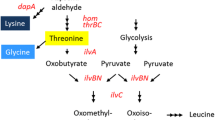Summary
Corynebacterium glutamicum effectively secretes isoleucine when the precursor 2-ketobutyrate is added to the medium. Isoleucine secretion was studied under different conditions with respect to various parameters, i.e. rate of isoleucine excretion and uptake, concentration gradients of isoleucine, other amino acids and ions, and membrane potential. By comparing these parameters in the presence and absence of the amino acid precursor it has been shown that the efflux of isoleucine in C. glutamicum can neither be explained by a passive diffusion mechanism nor by a process involving functional inversion of the isoleucine uptake carrier. Based on our results concerning the distribution of metabolites and the kinetics of excretion we conclude that isoleucine is excreted in C. glutamicum by a separate, presumably active efflux carrier system.
Similar content being viewed by others
References
Bunch AW, Harris RE (1986) The manipulation of microorganisms for the production of secondary metabolites. Biotechnol & Genet Eng Rev 4:117–144
Clément Y, Lanéelle G (1986) Glutamate excretion mechanism in Corynebacterium glutamicum: triggering by biotin starvation or by surfactant addition. J Gen Microbiol 132:925–929
Clément Y, Escoffier B, Trombe MC, Lannéelle G (1984) Is glutamate excreted by its uptake system in Corynebacterium glutamicum? A working hypothesis. J Gen Microbiol 130:2589–2594
Demain AL, Birnbaum J (1968) Alteration of permeability for the release of metabolites from the microbial cell. Curr Top Microbiol Immunol 46:1–25
Driessen AJM, Hellingwerf KJ, Konings WN (1987) Mechanism of energy coupling to entry and exit of neutral and branched chain amino acids in membrane vesicles of Streptococcus cremoris. J Biol Chem 262:12438–12443
Ebbighausen H, Weil B, Krämer R (1989) Transport of branched-chain amino acids in Corynebacterium glutamicum. Arch Microbiol 151:238–244
Eggeling I, Cordes C, Eggeling L, Sahm H (1987) Regulation of acethydroxy acid synthase in Corynebacterium glutamicum during fermentation of α-ketobutyrate to l-isoleucine. Appl Microbiol Biotechnol 25:346–351
Hoischen C, Krämer R (1989) Evidence for an efflux carrier system involved in the secretion of glutamate by Corynebacterium glutamicum. Arch Microbiol (in press)
Kikuchi M, Nakao Y (1986) Glutamic acid. In: Aida K, Chibata I, Nakayama K, Takinami K, Yamada H (eds) Progress in industrial microbiology, vol 24. Kodansha, Tokyo. Elsevier, Amsterdam, pp 101–116
Kinoshita S (1985) Glutamic acid bacteria. In: Demain AL, Solomon NA (eds) Biology of industrial microorganisms. Benjamin/Cummings, London, pp 114–142
Klingenberg M, Pfaff E (1967) Means of terminating reactions. In: Colowick SP, Kaplan NO, Estabrook RW, Pullman ME (eds) Methods in enzymology, vol 10. Academic Press, New York, pp 680–684
Miyajima R, Shiio I (1972) Regulation of aspartate family amino acid biosynthesis. VI. Effects of isoleucine and valine on threonine dehydrates and its formation. J Biochem 71:951–960
Nunheimer TD, Birnbaum J, Ihnen ED, Demain AL (1970) Product inhibition of the fermentative formation of glutamic acid. Appl Microbiol 20:215–217
Rottenberg H (1979) The measurement of membrane potential and pH in cells, organelles, and vesicles. In: Fleischer S, Packer L (eds) Methods in enzymology, vol LV. Academic Press, New York, pp 547–569
Saier JRM (1979) The role of the cell surface in regulating the internal environment. In: Gunsalus IC, Sokatch JR, Ornston LN (eds) The bacteria, vol VII. Academic Press, New York, pp 167–227
Shiio S, Otsuka SI, Takahashi M (1962a) Effect of biotin on the bacterial formation of glutamic acid. I. Glutamate formation and cellular permeability of amino acids. J Biochem 51:56–62
Shiio I, Otsuka SI, Katsuya N (1962b) Effect of biotin on the bacterial formation of glutamic acid. II. Metabolism of glucose. J Biochem 52:108–116
Shiio I, Otsuka SI, Katsuya N (1963) Cellular permeability and extracellular formation of glutamic acid in Brevibacterium flavum. J Biochem 53:333–340
Takinami K, Yoshii H, Tsuri H, Okada H (1965) Biochemical effects of fatty acid and its derivatives on glutamic acid fermentation. Part III. Biotin-tween 60 relationship in the accumulation of l-glutamic acid and the growth of Brevibacterium lactofermentum. Agric Biol Chem 29:351–359
Teshiba S, Furuya A (1983) Mechanisms of 5′-inosinic acid accumulation by permeability mutants of Brevibacterium ammoniagenes. III. Intracellular 5′-IMP pool and excretion mechanisms of 5′-IMP. Agric Biol Chem 47:2357–2363
Teshiba S, Furuya A (1984) Mechanisms of 5′-inosinic acid accumulation by permeability mutants of Brevibacterium ammoniagenes. IV. Excretion mechanisms of 5′-IMP. Agric Biol Chem 48:1311–1317
Author information
Authors and Affiliations
Rights and permissions
About this article
Cite this article
Ebbighausen, H., Weil, B. & Krämer, R. Isoleucine excretion in Corynebacterium glutamicum: evidence for a specific efflux carrier system. Appl Microbiol Biotechnol 31, 184–190 (1989). https://doi.org/10.1007/BF00262460
Received:
Accepted:
Issue Date:
DOI: https://doi.org/10.1007/BF00262460




